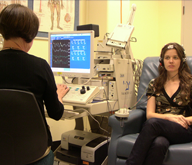Brainstem Auditory Evoked Potential (BAEP)

A brainstem auditory evoked potential (BAEP) is an evoked potential caused by an aural stimulus (a sound), usually a series of 'clicks'. Electrodes positioned on the scalp record responses to the sounds; these are then observed as a reading on an electroencephalogram (EEG). Responses to aural stimuli originate from relay structures within the brainstem. A doctor may recommend you go for a BAEP test if you have been experiencing changes in your hearing ability that may be due to problems with a particular nerve pathway. The changes in your hearing may not be complete hearing loss and may not be the same in both ears. From the BAEP a neurologist is able to determine the time it takes for an aural stimulus to travel from the point at the inner ear where the physical sound is translated into a bioelectrical impulse, to the brainstem. From these readings the neurologist can get an idea whether the auditory nerve is functioning properly. For example, an acoustic neuroma (a benign tumour of the ear canal) can stretch or compress the auditory nerve resulting in a long time for the processing of aural stimuli. The BAEP procedure itself is safe and non-invasive. For the procedure,

-
Some electrodes will be glued to particular spots on your scalp or earlobe.
-
You will be given special headphones or earplugs to wear.
-
It is important that you listen carefully to what the person conducting the test says and follow their instructions. You will then listen to a series of 'clicks' through headphones.
-
Responses to the clicks are recorded through the electrodes using special equipment.
-
After the procedure the electrodes will be removed from your head.
-
Your doctor will discuss the results of the test with you after they have been analysed; otherwise the referring doctor will.
